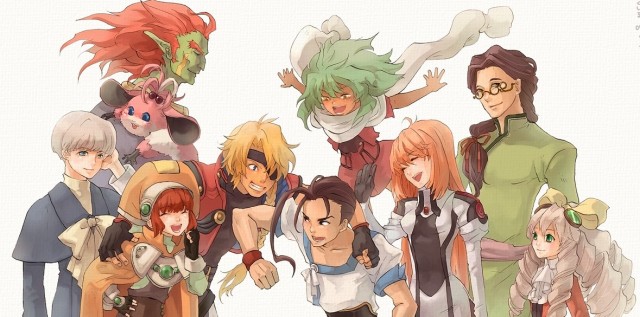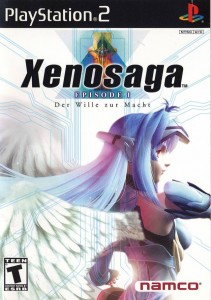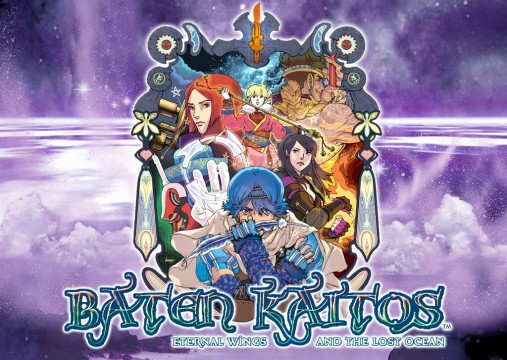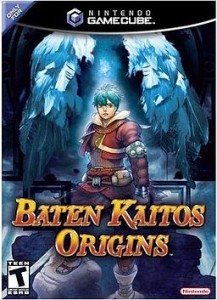 Over the past year, we’ve spent quite a lot of time talking about Xenoblade Chronicles here at Nintendojo. In no uncertain terms, we’ve expended thousands of words telling you just how much we loved it– we even named it best runner-up for our Game of the Year 2011. But what we haven’t spent so much time talking about is the studio behind it all and the developers who brought us this epic RPG in the first place. The name may be unfamiliar to some, but Monolith Soft has actually been around since 1999 and has produced a whole range of fantastic RPGs over the years, even if a good proportion of them have been for other consoles. So as we prepare to count down the next ninety-odd days on our calendars until April, let’s take some time getting to know the company who first put the “xeno” in Xenoblade.
Over the past year, we’ve spent quite a lot of time talking about Xenoblade Chronicles here at Nintendojo. In no uncertain terms, we’ve expended thousands of words telling you just how much we loved it– we even named it best runner-up for our Game of the Year 2011. But what we haven’t spent so much time talking about is the studio behind it all and the developers who brought us this epic RPG in the first place. The name may be unfamiliar to some, but Monolith Soft has actually been around since 1999 and has produced a whole range of fantastic RPGs over the years, even if a good proportion of them have been for other consoles. So as we prepare to count down the next ninety-odd days on our calendars until April, let’s take some time getting to know the company who first put the “xeno” in Xenoblade.
Co-founded by former Square employees Hirohide Sugiara and Tetsuya Takahashi, Monolith Soft is perhaps best known for its Xenosaga series over on PlayStation 2. Before he left Square, Sugiara had worked in a number of different roles across a wide variety of games, his most famous being the producer of PlayStation beat-’em-up Ehrgeiz. Takahashi, on the other hand, had cut his teeth in the art departments of Final Fantasy IV, Romancing SaGa and Final Fantasy V before going on to become graphics director for both Chrono Trigger and Final Fantasy VI. His big break came in 1998 when he wrote and directed Xenogears, one of the most revered RPGs on PlayStation. An ambitious title for its time, Xenogears tackled the theories and philosophies of Friedrich Nietzsche, Sigmund Freud and Carl Jung within the themes of its plot, probed theological and psychological issues and debated the nature of identity, and perhaps most importantly, began Takahashi’s enduring fascination with the relationship between man and machine.

Xenogears featured a host of colourful and vibrant characters from all corners of its vast world.
But Takahashi wasn’t happy with the way things were heading with Square. The wild success of the Final Fantasy games meant that all Square’s efforts were gradually being funnelled down a very narrow production line, and Takahashi didn’t like the idea of putting all the company’s eggs in one basket. So he left Square along with Sugiara in October 1999 to form his own company, Monolith Soft.
The fledging company got its first leg up into the industry from Namco, who bought an 80% share in their newly christened studio, and their first title reprised the “xeno” prefix in the form of Xenosaga Episode I: Der Wille zur Macht (or “The Will to Power” to you and me). While not a strict sequel (or indeed prequel) to Takahashi’s seminal Xenogears, Episode I contained more than a passing nod to its predecessor. The subtitle “Der Wille zur Macht” is itself a reference to Nietzsche’s posthumous collection of notebooks and its central themes revisited much of the same territory.
 Released in 2003 on PlayStation 2, it marked the beginning of a trilogy of games which would chart the epic journey of Shion, a young scientist at weapons manufacturer Vector Industries, and her battle android KOS-MOS as they fought a mysterious and hostile race of creatures from an alternate dimension known as the Gnosis. The game borrowed heavily from the realms of science fiction, and unlike most of its contemporaries it placed a great emphasis on its long, sprawling story, with cut-scenes that would give future Metal Gear Solid games a run for their money. It also delved into quite unusual and daring subject matter for a game, and some critics even warned that its use of religious symbolism may give offence to particular players.
Released in 2003 on PlayStation 2, it marked the beginning of a trilogy of games which would chart the epic journey of Shion, a young scientist at weapons manufacturer Vector Industries, and her battle android KOS-MOS as they fought a mysterious and hostile race of creatures from an alternate dimension known as the Gnosis. The game borrowed heavily from the realms of science fiction, and unlike most of its contemporaries it placed a great emphasis on its long, sprawling story, with cut-scenes that would give future Metal Gear Solid games a run for their money. It also delved into quite unusual and daring subject matter for a game, and some critics even warned that its use of religious symbolism may give offence to particular players.
But the game’s narrative and its cast of intriguing, well-rounded characters weren’t the only impressive things about Episode I. The depth of its gameplay mechanics provided RPG fans with a refreshingly complex battle system that required much more planning and strategy than other RPGs on the market, and while fights were still turn-based all your enemies were roaming the environments in plain sight, eliminating the tedium of random encounters. It wasn’t perfect by any means, but Monolith Soft’s first offering certainly set a new standard for RPG story-telling and laid down many of studio’s most famous hallmarks.
However, it would be another two years before the next Xenosaga game would be released, and during that time Monolith Soft began development on an altogether different kind of game. It was still an RPG, but this time giant robots would be replaced by cards, and the thriving PlayStation 2 would be snubbed for the somewhat ailing GameCube. Co-developed with tri-Crescendo, Monolith Soft’s second title was the little-known gem Baten Kaitos: Eternal Wings and the Lost Ocean.
It was a complete thematic departure from the Xeno games and was developed with a completely new engine and style of gameplay. Directed by Hiroya Hatsushiba and Yasuyuki Honne and written by Masato Kato and Kenya Hirata, Baten Kaitos took place in a world where humanity now lives in the sky, and all memories of the ocean and the world below have faded into obscurity. But the evil force that supposedly sucked the ocean dry and sent the world skyward has begun to reawaken, and Kalas and his companion Xelha must unite the people against the malicious Empire if they’re to save their world from destruction and uncover the mysteries of the past.

Players took control of Kalas’ guardian spirit and helped to guide him through a world rife with corruption and tyrannical despots.
The story was perhaps a little less audacious than Xenosaga, but what Baten Kaitos lacked in philosophical debate it made up for in spades with its distinctive battle system and exquisite environments. In a rather bizarre mix of genres, the game’s main mechanics focused on the use of magical cards known as Magnus, which could store real life objects in card-form by absorbing their Magna essence. There were Magnus cards for everything from weapons to foodstuffs, and during battle every character had their own deck of Magnus cards at their disposal instead of a standard RPG menu system. Each card also had its own spirit number attached to it, and players could use these numbers to their advantage by creating a string of combo attacks or adding special effects if they used certain cards one after the other. It proved to be a unique and invigorating approach to the RPG battle system, and it established another cornerstone of the Monolith Soft tradition by creating an accessible yet highly intricate gameplay experience that was both fast paced and deceptively intelligent. We certainly loved it, as did many other critics, but unfortunately a combination of poor marketing and lacklustre sales meant that Baten Kaitos has since become something of a cult hit among fans, and many missed the title altogether.
That wasn’t the case for Monolith Soft’s next title though, the eagerly anticipated second instalment in the Xenosaga franchise– Episode II: Jenseits von Gut und Böse (“Beyond Good and Evil”– another work of Nietzsche). Released in 2005, Episode II was once again directed by Takahashi and picked up where Episode I left off. However, Episode II ultimately fell victim to a number of complaints as Monolith Soft tried to refine the original Xenosaga formula, and critics were divided over the choice of new voice actors and the more mature and realistic art direction. The changes to the battle system were also criticised, and fans disliked the watered down levels of customisation and the more homogenized set of character skills. Its 2006 sequel Episode III: Also sprach Zarathustra (“Thus spoke Zarathustra”– the title of Nietzsche’s most famous novel) performed considerably better, however, and managed to address many of its predecessor’s flaws. Original voice actors were brought back, battle loading times were addressed, and the more specialised character abilities from Episode I made a triumphant return. Nevertheless, Episode III also marked the end of what was meant to be a series of six games, and Xenosaga’s grand space opera was brought to a somewhat hurried (though neatly wrapped up) conclusion.
 The same year Monolith Soft released Baten Kaitos: Origins, a prequel to the original game set 20 years earlier. Despite the criticisms the studio faced over Xenosaga Episode II’s controversial changes, Origins also received a number of substantial enhancements to its core mechanics, only this time it succeeded in every possible way. It made for a fantastic successor to the Baten Kaitos name, and it demonstrated that Monolith Soft had overcome their previous sequel teething problems. One of its only flaws was that it sold just as poorly as its predecessor due to the imminent arrival of Wii.
The same year Monolith Soft released Baten Kaitos: Origins, a prequel to the original game set 20 years earlier. Despite the criticisms the studio faced over Xenosaga Episode II’s controversial changes, Origins also received a number of substantial enhancements to its core mechanics, only this time it succeeded in every possible way. It made for a fantastic successor to the Baten Kaitos name, and it demonstrated that Monolith Soft had overcome their previous sequel teething problems. One of its only flaws was that it sold just as poorly as its predecessor due to the imminent arrival of Wii.
But the studio was about to face some major changes of its own the following year when Namco sold 80% of its 96% stake in the company to Nintendo. Citing considerations involving the future growth of Monolith Soft and a desire to strengthen its relationship with Nintendo, Namco handed over the Monolith reins to the big N in May 2007 and eventually sold its remaining 16% share to make Monolith Soft a first party subsidiary of Nintendo.
RPG-starved Nintendo fans rejoiced. Having long envied the swathe of top-quality RPGs being released on rival consoles, many had hoped that Nintendo’s acquisition of Monolith Soft would signal a revitalisation of the genre, and possibly even bring back the RPG glory days of the SNES era given Monolith Soft’s outstanding track-record.
Yet its first two major releases under this new arrangement were the somewhat ill-fated Soma Bringer for DS and the woefully average Disaster: Day of Crisis for Wii, neither of which made it to North America. Instead, the US was treated to the surprisingly robust Dragon Ball Z: Attack of the Saiyans and a Super Robot Taisen OG Saga title co-developed with Banpresto, but even though both games received high praise for their battle systems, they were hardly the epic RPGs fans had been crying out for. Rather, it almost seemed like Monolith Soft was pulling a Rare and abandoning its vision of creating truly original, ground-breaking games altogether.
But just when we thought all was lost they went and released Xenoblade Chronicles in 2010 (2011 in Europe) and completely revolutionised the RPG all over again. It struck the perfect balance between ease and intricacy with its battle system, created a vast world even more beautiful than Baten Kaitos, and told an enthralling story that was just as ambitious as Xenosaga. It built on ten years worth of games and experience and delivered one of the most outstanding experiences of this generation, with Takahashi himself calling it “a fitting tribute to our first decade at Monolith Soft.” With the team now rumoured to be back in the throes of development for their next game, we can only hope that their future titles for Wii U and 3DS will be just as exceptional.




 ShareThis
ShareThis







I actually own the first Baten Kaitos, but I’ve yet to play it. :X
Maybe I should start that before Xenoblade comes out here…
Despite the fact that I had to go through about three copies of the game to actually finish it, I’d highly recommend Baten Kaitos, especially since Xenoblade is likely to consume your entire life once it’s released! :)
Baten Kaitos is probably among my favorite GameCube games, although granted it was one of the only JRPGs on the system, so it was a bit of a given. A better story could probably be found in a lot of other games though …
Baten Kaitos is a solid game, albeit with more bad voice acting than good. Its prequel, Baten Kaitos Origins, is one of my favorite RPGs of all time, as evidenced by my Nintendojo avatar; only with Xenoblade has Monolith finally eclipsed BKO, in my opinion.
I actually played Disaster: Day of Crisis as a test drive for my PAL-enabled Wii, and while its rough edges are clearly evident — bland graphics, irritating driving sequences — I thought it exhibited more charm than I expected. The game was such an over-the-top mishmash of disasters that I kept looking forward to what crazy thing was going to happen next. Going from a tsunami to a volcano? Awesome.